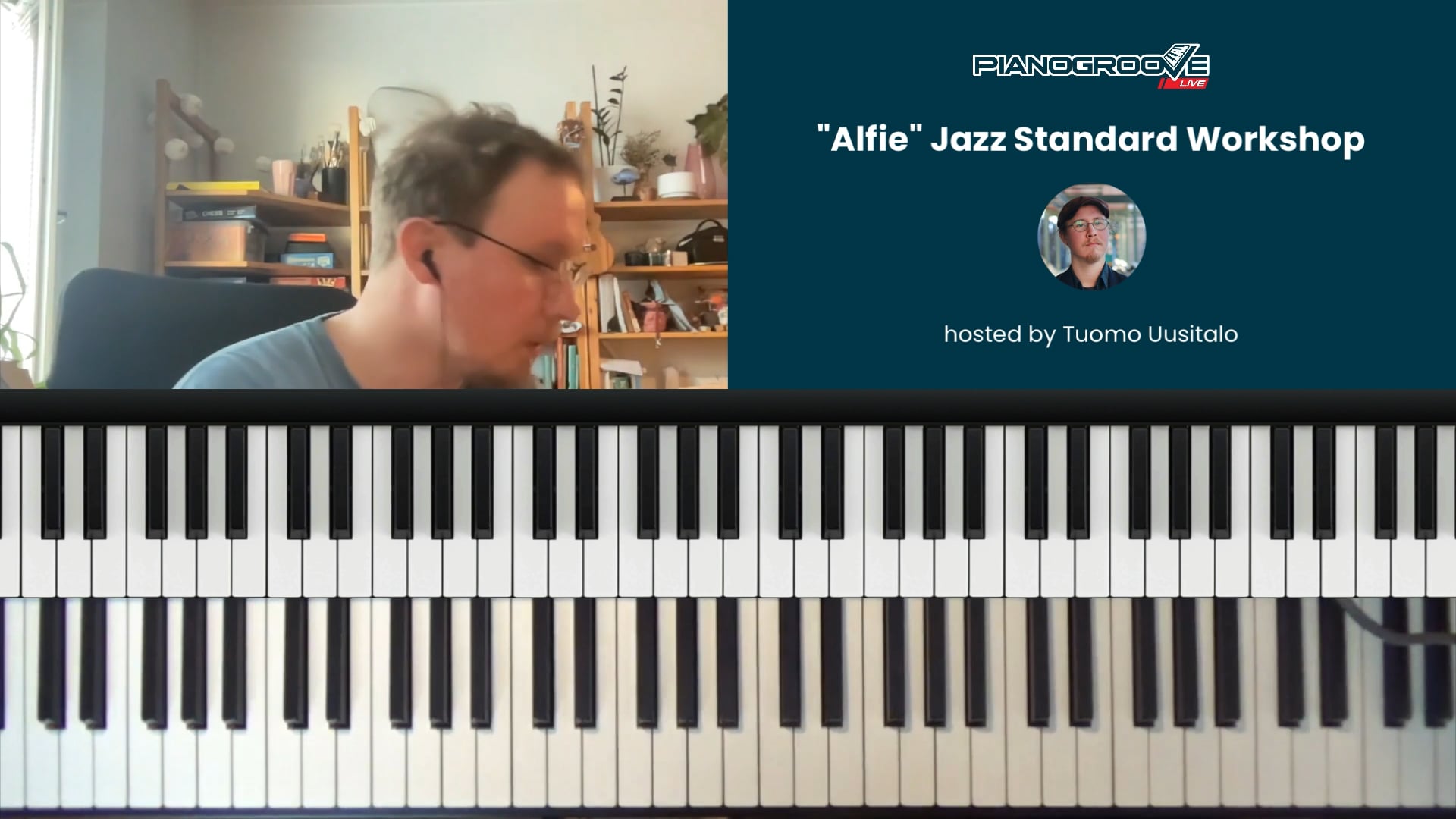

Tuomo Uusitalo
Tuomo is an award-winning pianist, composer, arranger and educator. Having released two albums as a leader, he has established himself in the New York jazz scene and continues touring internationally both as a leader as well as sideman.
Live Seminar Resources
Live Seminar Resources
PDF Downloads
- Seminar Handout
Join PianoGroove Pro to access all downloads and learning resources.
Download theory supplements, midi files, chord changes and full note-for-note transcriptions of every lesson.
- Alfie - Lead Sheet
Join PianoGroove Pro to access all downloads and learning resources.
Download theory supplements, midi files, chord changes and full note-for-note transcriptions of every lesson.
- Alfie - Chord Chart
Join PianoGroove Pro to access all downloads and learning resources.
Download theory supplements, midi files, chord changes and full note-for-note transcriptions of every lesson.
Seminar Description
Seminar Description
"Alfie" Jazz Standard Workshop
Welcome to this month’s Jazz Standard Workshop, where we explore the classic ballad "Alfie." This tune, composed by Burt Bacharach with lyrics by Hal David, is a staple in the jazz repertoire. Known for its lyrical melody and sophisticated harmony, "Alfie" provides an excellent opportunity to refine our understanding of chord movement, harmonic substitutions, and reharmonization techniques.
Understanding the Basic Harmony
We begin by examining the lead sheet to identify the core harmonic structure of the tune. The song is typically played in A-flat major, though alternative keys such as C major are also common. The A sections revolve around a 1-5-1 progression, while we also see 2-5-1 movements to reinforce the harmonic flow. One distinctive feature of "Alfie" is the use of diminished passing chords, which add tension before resolving smoothly into major harmonies.
The B section presents a slight harmonic departure, briefly implying a modulation to G minor with a Bb pedal point that creates an ambiguous harmonic space. Understanding modal interchange chords in this section helps us grasp how jazz musicians incorporate unexpected harmonic colors into their arrangements.
Harmonic Substitutions & Variations
Listening to different interpretations of "Alfie" helps us analyze how jazz musicians rearrange harmonies while keeping the essence of the tune intact. In our session, we explored recordings by Bill Evans and Brad Mehldau, both of whom take unique approaches to the chord voicings and harmonic rhythm.
Bill Evans’ Interpretation
The Bill Evans interpretation utilizes tritone substitutions to create additional harmonic movement and employs dominant chords leading into the relative minor for a smooth yet sophisticated sound.
- Introduces voice leading techniques that enhance the melodic and harmonic interplay.
Brad Mehldau’s Interpretation
- Maintains a simpler harmonic structure in the early sections, allowing space for expressive phrasing.
- Avoids traditional dominant-to-minor resolutions, favoring more open and ambiguous voicings.
- Demonstrates the power of sparse bass playing, where single notes define the harmony without overcrowding the arrangement.
The Importance of Listening
To fully absorb the nuances of "Alfie," we encourage you to listen to vocal and instrumental versions, including recordings by Dionne Warwick, Nancy Wilson, and Monica Zetterlund. Studying vocal renditions helps us interpret the melodic phrasing and lyrical intent, while instrumental versions showcase harmonic exploration and improvisational techniques.
Practice Tips
- Identify 2-5-1 Progressions – These are the backbone of jazz harmony. Spot them in different sections and practice transitioning smoothly between them.
- Experiment with Diminished Chords – Try replacing dominant chords with diminished passing chords to enhance harmonic movement.
- Analyze Different Voicings – Listen to Bill Evans and Brad Mehldau’s versions to compare their chord choices and voice leading.
- Play with Harmonic Rhythm – Some sections of "Alfie" have irregular bar lengths. Work on feeling the phrasing rather than counting bars rigidly.
- Listen & Transcribe – Pick a version of "Alfie" and transcribe a section to internalize voicings, phrasing, and substitutions.
By the end of this lesson, you’ll have a deeper harmonic understanding of "Alfie" and new tools to apply to your jazz repertoire. Keep experimenting, and see you in the next workshop!








It would be nice if the score was shown when analyzing the composition. It could also be that this seminar is for advanced students. Perhaps Hayden can make a basic tutorial someday.
Hi Orlando,
I have sent this video to our video editor who will add the score and the blue highlights. It should be ready in a few days.
I’ll reply to this comment when it’s ready.
Also yes I can certainly cover this tune in a beginner tutorial – I have added it to our upcoming lesson schedule.
Talk soon,
Hayden
Hey Orlando,
Just to let you know this video has now been edited and the notation added.
Enjoy working on this tune!
Cheers,
Hayden
Hi Hayden,
I am very grateful to you. In my opinion, the seminar is very well prepared and the visualization of the score is very useful to understand Tuomo’s explanations. Also the description of where to pay attention as well as the practice tips.
There’s a lot to work on. As a beginner I’m going to try to work with an even more simplified version. I’ll need months (and years for others versions).
Best regards,
Orlando